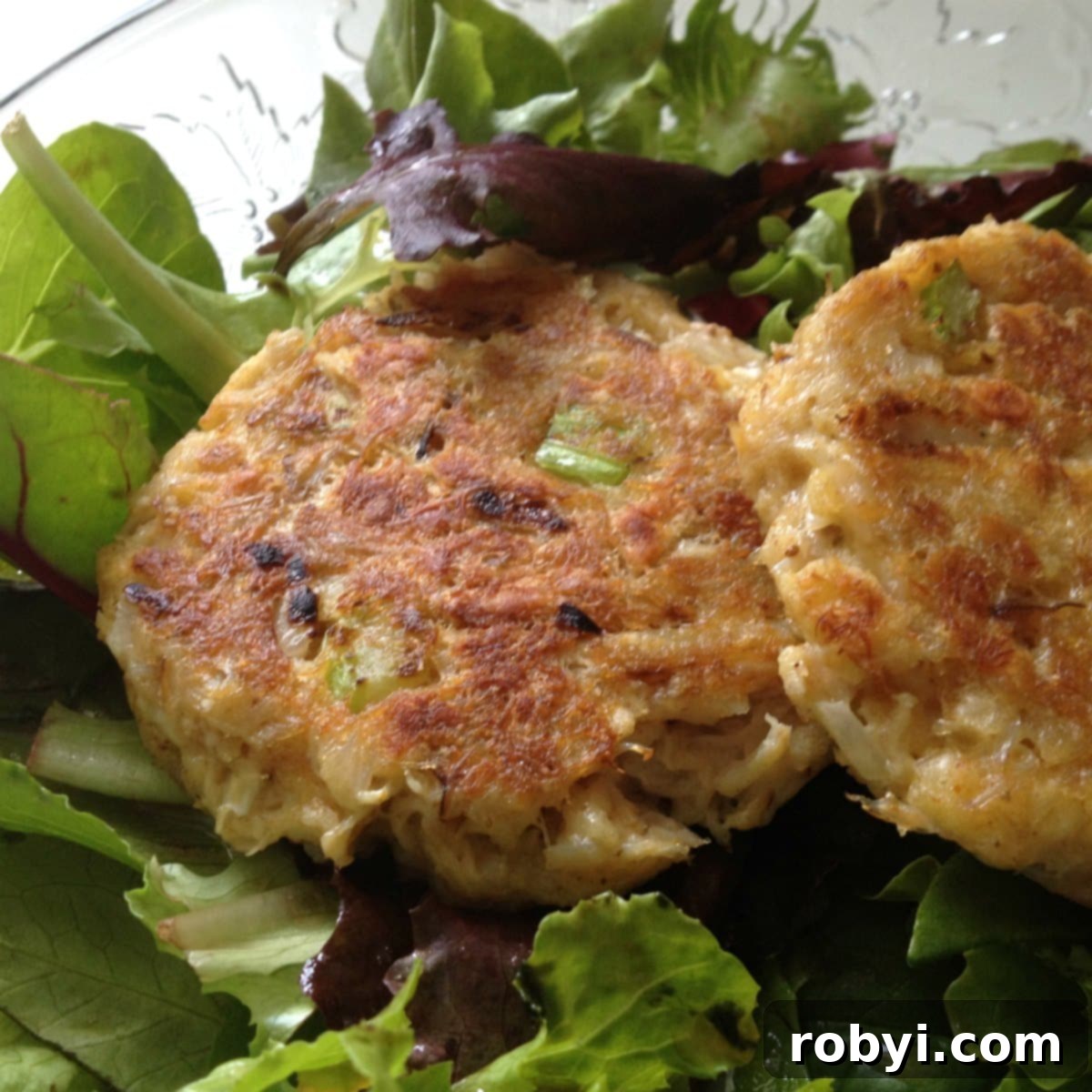Authentic Maryland Style Lump Crab Cakes: The Ultimate Eggless Recipe
Welcome to the definitive guide for crafting the most delectable Maryland Style Lump Crab Cakes you’ll ever taste. This recipe isn’t just a favorite; it’s a culinary staple, perfected over hundreds of preparations at our very own meal assembly store. What makes it stand out? It’s incredibly quick, straightforward, entirely eggless, and offers the versatility of being either baked or pan-fried to golden perfection. The best part? You can easily freeze these beauties, ensuring you always have a gourmet treat ready to enjoy on a whim, making them perfect for busy weeknights or unexpected celebrations.
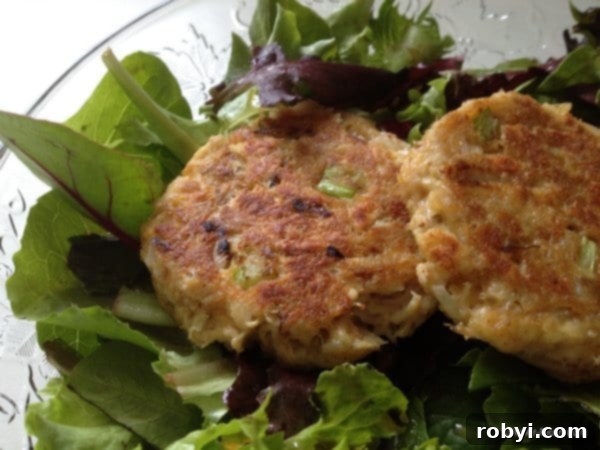
Our household has an undeniable passion for crab, a sentiment that inspired us to create and perfect this recipe. After a delightful weekend of cracking crab legs, it became clear that it was high time to share this cherished seafood recipe with you. For a while, these crab cakes were a rare indulgence, primarily because we sought a way for our daughter, who has egg and soy allergies, to enjoy them safely. The traditional binding agent, mayonnaise, was a hurdle. However, the advent of delicious egg-free and soy-free mayonnaise revolutionized our approach, putting these incredible crab cakes back on our regular dinner rotation. This simple substitution means everyone can savor the rich flavors of this classic dish without compromise. For another equally delightful variation, be sure to explore our Easy Baked Crab Cakes made with Avocado.
Why Our Maryland Crab Cakes Stand Out: The True Taste of Tradition
The essence of a true Maryland crab cake lies in its simplicity and an unwavering commitment to quality crab meat. Unlike many recipes that rely heavily on fillers, our method ensures that the sweet, delicate flavor of the crab remains the undeniable star of the show. There’s an unspoken rule in Maryland: the crab-to-breading ratio must heavily favor the crab. No, no, no, we would never let breading overshadow the exquisite meat! This philosophy is precisely why our crab cakes proudly carry the “Maryland-style” title. They boast an impeccable balance of succulent lump crab meat, just enough binding and breading to hold it together, and a symphony of classic seasonings that enhance, rather than mask, the natural flavors of the sea.
Can you almost taste the fresh crab peeking through each golden-brown bite? Nothing evokes the spirit of summer gatherings or special occasions quite like a perfectly crafted crab cake. We particularly love serving them atop a bed of crisp salad greens, drizzled with a vibrant red wine vinaigrette dressing, for a meal that feels both indulgent and refreshing.
Ingredients for Success: Choosing the Right Crab Meat
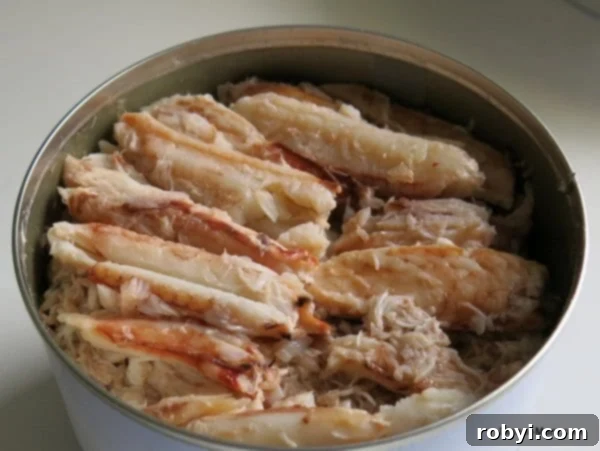
The journey to an exceptional crab cake begins with the foundation: the crab meat itself. For truly authentic Maryland-style crab cakes, the choice of crab meat is paramount. You’ll want to seek out high-quality, pasteurized crab meat, typically found in the refrigerated seafood section of your grocery store – not the canned goods aisle. The grade of crab meat significantly impacts both texture and flavor, and your budget will often guide your selection. Here’s a quick guide to understanding the different grades:
- Jumbo Lump: These are the largest, most visually impressive pieces of white meat, primarily from the swimming fins of the crab. They have a delicate texture and sweet flavor, making them ideal for showcasing in dishes like crab cakes where the crab is the star. They are also the most expensive.
- Lump: Slightly smaller than jumbo lump, these are still substantial pieces of white body meat. Lump crab meat offers an excellent balance of presentation and flavor, making it a popular choice for premium crab cakes, providing that desirable “lumpy” texture.
- Backfin: This grade consists of smaller broken pieces of lump crab meat combined with flakes of white body meat. It’s a good all-purpose crab meat, more economical than lump, and works well in crab cakes where a slightly less chunky texture is acceptable.
- Claw: Darker in color and with a stronger flavor profile, claw meat comes from the crab’s claws. It’s often used in soups, dips, or as a flavorful addition to dishes where its robust taste can shine. While delicious, it’s not typically used for classic lump crab cakes due to its color and firmer texture.
For this recipe, we highly recommend using lump crab meat to achieve that signature Maryland texture where you can truly appreciate each tender morsel. While jumbo lump is a luxurious choice, lump meat provides excellent value and authentic results.
Crafting Your Crab Cake Mixture: A Symphony of Flavors
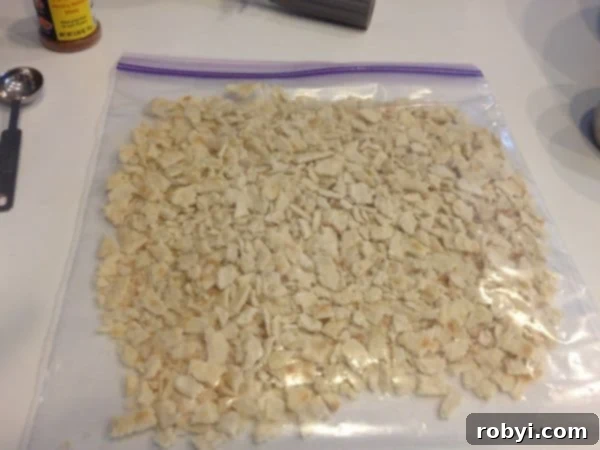
Preparation is key to a smooth cooking process. Before you begin assembling, take the time to prep all your ingredients. This mise en place ensures a seamless transition from mixing bowl to pan. First, crush approximately 28-30 saltine crackers. A simple plastic bag and a rolling pin work wonders for this task, yielding fine crumbs that will act as our minimal binder. You can also get creative here; whole wheat, low-salt, or even gluten-free crackers perform beautifully, offering flexibility for various dietary needs. Next, finely dice your onion and celery. The goal is to have small, uniform pieces that will blend harmoniously into the mixture without dominating the delicate crab.
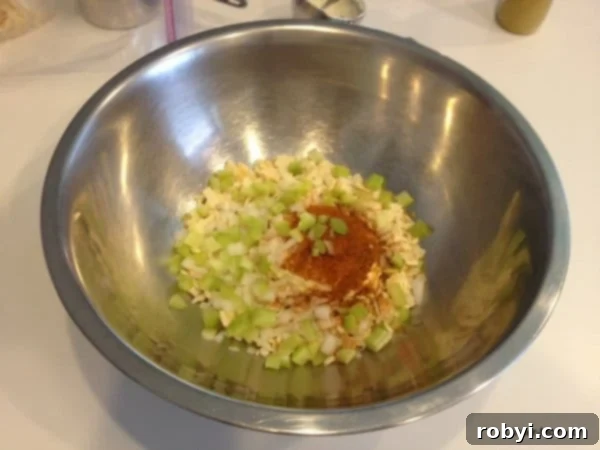
Once your ingredients are prepped, gather everything except the precious crab meat into a large mixing bowl. Into the bowl will go the finely crushed saltines, diced onions, diced celery, your chosen mayonnaise (remember, egg-free and soy-free for allergy-friendly versions), a touch of spicy brown mustard for a subtle kick, and the iconic Old Bay seasoning – the undisputed king of Maryland flavors. Mix these ingredients thoroughly until they are well combined. This ensures that the binders and seasonings are evenly distributed before the crab is introduced.
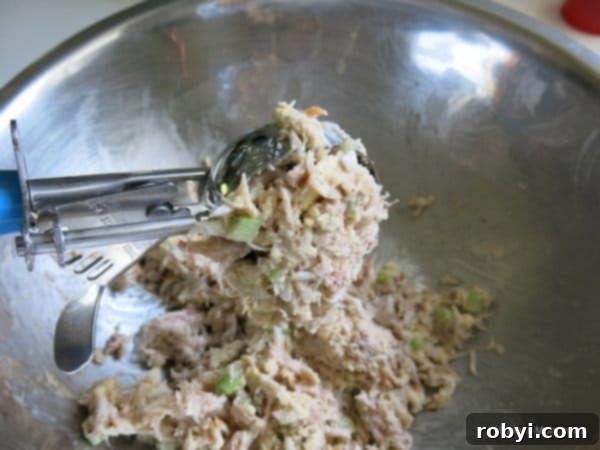
Now, for the most crucial step: gently fold in the crab meat. The operative word here is “gently.” Over-handling delicate lump crab meat is the cardinal sin of crab cake making, as it breaks down the beautiful lumps and results in a mushier texture. We want those distinct pieces of crab to remain intact, providing bursts of authentic flavor and a satisfying texture with every bite. Mix just enough to incorporate the crab without crushing it, leaving plenty of glorious lumps visible.
Forming the Perfect Crab Cakes
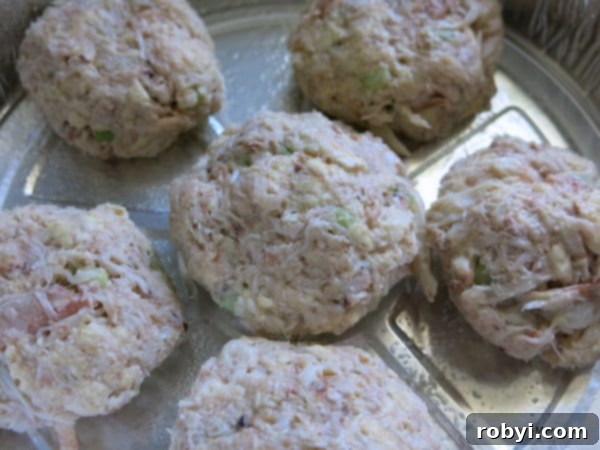
To ensure uniform cooking and presentation, measure out ¼ cup portions of the crab mixture. This size consistently yields 12 perfectly sized crab cakes. We find that a #16 disher scoop is an invaluable tool for this task, creating perfectly portioned and compact mounds. While you can certainly make them smaller for appetizer-sized crab balls, or even larger if you prefer, we’ve found that anything significantly bigger than ¼ cup can become quite challenging to pan-fry without falling apart. The delicate nature of these crab-centric cakes requires a mindful approach.
Once you’ve scooped your portions, compress them tightly into a slightly rounded patty. Resist the urge to flatten them completely; a slightly domed shape helps maintain moisture and prevents them from drying out during cooking. For an even more robust and stable crab cake, it’s highly recommended, though not strictly necessary, to let the formed patties rest in the refrigerator for up to an hour. This chilling period allows the binders to firm up completely, ensuring your crab cakes hold their shape beautifully during cooking.
Cooking Your Crab Cakes: Pan-Fried vs. Baked
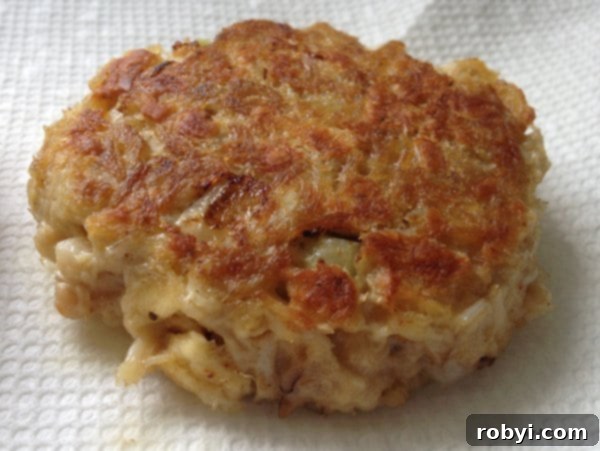
You have two fantastic choices for cooking these culinary delights: pan-frying for a classic crispy exterior or baking for a lighter, often healthier, alternative. Both methods deliver delicious results, so choose the one that best suits your preference and occasion.
Pan-Frying for Golden Perfection
If you crave that irresistible golden-brown crust and a slightly crispy texture, pan-frying is the way to go. It brings out a rich depth of flavor and creates a wonderful contrast with the tender interior. To pan-fry:
- Heat about ¼ cup of olive oil in a large frying pan over medium-high heat. You want the oil to shimmer gently, indicating it’s ready for cooking.
- Carefully add about 4 patties to the pan at a time, ensuring not to overcrowd the pan. Overcrowding can lower the oil temperature and lead to uneven cooking.
- Cook for approximately 2-3 minutes on each side, or until they achieve a beautiful golden-brown color. This requires patience and precision.
- The crucial step: turn them carefully just once. These crab cakes are inherently fragile due to their high crab content and minimal binder. Multiple flips will almost certainly cause them to break apart.
- Once cooked, remove the crab cakes to a plate lined with paper towels. Let them drain and rest for about 3 minutes. This resting period is vital, allowing any excess oil to drain off and helping the internal structure of the crab cakes to firm up even further.
Baking for a Lighter Touch
For those seeking a lighter meal or a less hands-on cooking process, baking offers an equally delightful, and often healthier, alternative. This method is also more forgiving given the delicate nature of the crab cakes, as it eliminates the need for careful flipping in hot oil. To bake your crab cakes:
- Preheat your oven to 350 degrees F (175 degrees C).
- Lightly coat a baking tin or sheet with cooking spray to prevent sticking.
- Arrange the crab cakes on the prepared baking sheet, leaving a little space between each.
- Bake uncovered for approximately 35-45 minutes, or until the crab cakes are golden brown and heated through.
- For even browning, flip them once about halfway through the baking process. This gentle flip is far less precarious than pan-frying.
This baking method works wonderfully for other seafood cakes too, such as salmon cakes, and can even be adapted for muffin tins for perfectly portioned, individual servings!
Expert Tips for Impeccable Crab Cakes
Drawing from years of experience making these at our meal assembly store, we’ve gathered some indispensable advice to help you achieve crab cake perfection:
Tip #1: Embrace the Single Flip
This is perhaps the most critical rule, especially for pan-frying. You must resist the urge to turn the crab cakes multiple times. Their delicate structure will simply not withstand repeated handling. If you’re unsure about timing, it might be necessary to sacrifice one crab cake – use it as your test subject. Peek underneath to gauge the browning and adjust your timing accordingly. Once you have a sense of the ideal cooking duration for the first side, commit to a single, confident flip for the remaining cakes. Your patience will be rewarded with beautifully intact, perfectly cooked crab cakes.
Tip #2: Respect the Patty’s Shape
When pan-frying, avoid being a “crab cake smasher” with your spatula, especially on the first side. Maintain the slightly molded, rounded shape of the crab cake as it cooks. This helps it develop a nice crust and retain moisture. Once you’ve successfully flipped it and it has cooked for about a minute on the second side, you can very gently press it down just a bit with your spatula if you desire a slightly flatter cake. But remember, a light touch is key. Over-compressing can force out the valuable juices and lead to a dry crab cake.
Tip #3: The Indispensable Rest
Once your crab cakes are cooked, whether pan-fried or baked, do not skip the resting period. Allow them to drain on paper towels for a few minutes after cooking. This step is not merely about removing excess oil; it allows the internal structure of the crab cakes to firm up and “set.” Just like a perfectly cooked steak, resting helps the flavors meld and the texture stabilize, resulting in a more cohesive and enjoyable crab cake.
Tip #4: Don’t Overmix
We’ve already touched on this, but it bears repeating. Overmixing is the enemy of a lump crab cake. The goal is to bind the ingredients just enough so the cakes hold together, while still preserving the distinct, flaky texture of the crab meat. Use a gentle folding technique and stop as soon as the ingredients are combined. The more you mix, the more you break down the crab, and the less “lumpy” your lump crab cakes will be.
Serving Suggestions & Flavor Pairings
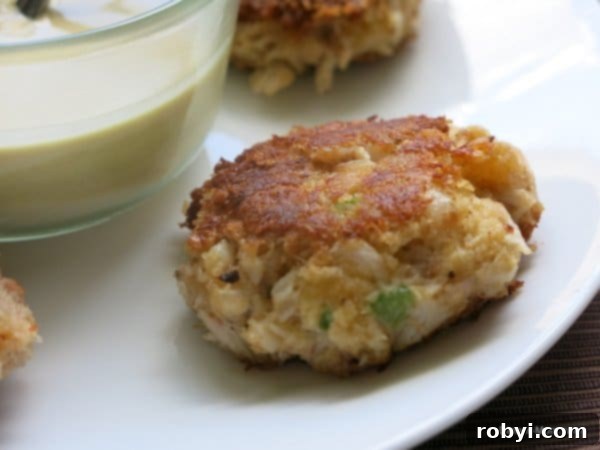
Once your Maryland Style Lump Crab Cakes are perfectly cooked, it’s time to complete the culinary experience. These versatile cakes pair wonderfully with a variety of accompaniments. For a simple yet elegant presentation, we love serving them with fresh lemon wedges, allowing the bright citrus to cut through the richness of the crab. A classic pairing is a homemade remoulade sauce, offering a creamy, tangy complement. You can easily whip up a quick sauce by mixing a little mayonnaise with spicy brown mustard, a dash of Old Bay, and a squeeze of lemon juice.
Beyond sauces, consider serving your crab cakes over a bed of mixed salad greens with a light vinaigrette for a refreshing contrast, or alongside classic summer sides like coleslaw, corn on the cob, or roasted asparagus. For a more hearty meal, offer them with fluffy rice pilaf or roasted potatoes. They also make an excellent main course for a seafood-themed dinner party, promising to impress your guests with their authentic flavor and elegant presentation.
Customizing Your Crab Cake Experience
One of the beauties of this Maryland Style Lump Crab Cake recipe is its adaptability. You can easily tailor it to fit various dietary needs or occasions:
Dietary Adaptations:
- Egg-Free and/or Lower in Fat: Simply use an appropriate egg-free mayonnaise (as we do for our allergy-friendly version) and consider low-fat or light mayonnaise options. Additionally, explore whole wheat or low-salt crackers for the breading to further enhance the health profile. Our Easy Baked Crab Cakes made with Avocado also offer a naturally lower-fat, egg-free alternative using avocado as a binder.
- Gluten-Free: Achieving a gluten-free version is wonderfully simple. Just substitute standard saltine crackers with your favorite brand of gluten-free crackers. The texture and binding properties will remain consistent, ensuring delicious results for everyone.
Appetizer-Sized Crab Balls:
Transform these delightful crab cakes into charming, bite-sized appetizers, often referred to as “crab balls.” To do this, make tablespoon-sized portions, which will yield approximately 48 smaller cakes. For this diminutive size, baking is typically the easiest and most efficient cooking method. Arrange them on a greased baking sheet and bake in a 350 degrees F (175 degrees C) oven for about 30 minutes, flipping once if desired for even browning. They’re perfect for entertaining or a lighter snack.
Freezing for Future Enjoyment:
These crab cakes freeze beautifully, making them an excellent choice for meal prep or for having a gourmet option on hand for impromptu treats or planned special occasions. To freeze:
- Form the crab cakes into their desired patties.
- Place them in a single layer in an aluminum tin or on a baking sheet.
- If using a tin, cover it tightly with a lid and then wrap it securely with plastic wrap to prevent freezer burn. If using a baking sheet, freeze the cakes until solid, then transfer them to a freezer-safe plastic bag or airtight container. This prevents them from sticking together.
- For best results, consume within 2 months of freezing to maintain optimal flavor and texture.
- When ready to cook, defrost the crab cakes completely in the refrigerator. Do not cook from frozen.
- Once defrosted, you may find it helpful to gently compress the patties again to ensure they are firm before cooking according to the pan-frying or baking instructions.
Having a batch of these exquisite crab cakes in your freezer is a true luxury, ready to elevate any meal with minimal effort. You’ll often find this recipe highlighted in our collection of Special Occasion Dinners.
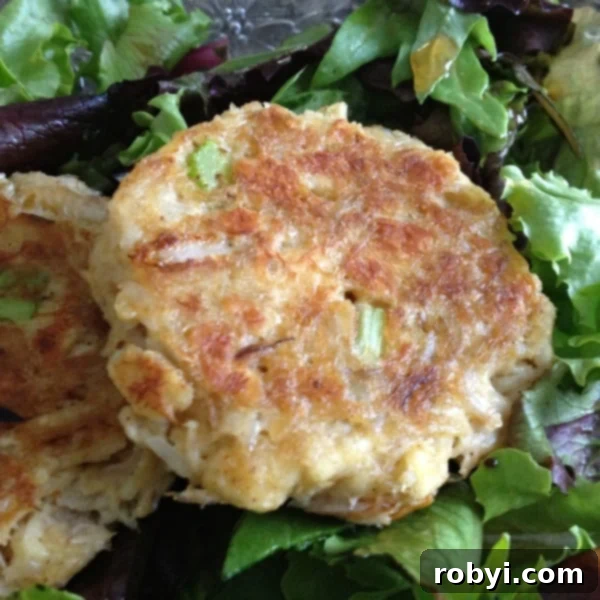
Would you like more easy, healthy, carb-conscious recipes?
📋 Recipe: Maryland Style Lump Crab Cakes

Maryland Style Lump Crab Cakes
Maryland style lump crab cakes are the perfect combination of meat, breading and spices. Follow our expert tips and suggestions to perfectly pan-fry or bake them in the oven. Prepare them ahead and freeze using our proven instructions from our meal assembly store, ensuring deliciousness anytime.
Prep Time: 15 minutes
Cook Time: 10 minutes
Total Time: 25 minutes
Servings: 12 Crab Cakes
Author: Marjory Pilley
Ingredients
- 28 each Saltine Crackers, crushed
- ⅓ cup Mayonnaise (Egg-free recommended)
- 1 teaspoon Spicy Brown Mustard
- ¼ cup Onion, diced finely
- ¼ cup Celery, diced finely
- 1 teaspoon Old Bay Seasoning
- 16 ounces Crab Meat (Lump recommended)
- ¼ cup Olive oil (for pan-frying)
Instructions
- In a large bowl, combine the crushed saltine crackers, mayonnaise, spicy brown mustard, diced onion, diced celery, and Old Bay seasoning. Mix just until all ingredients are thoroughly combined.
- Add the lump crab meat to the bowl, gently breaking up any extra-large pieces.
- Very gently fold the crab meat into the cracker mixture until just combined. Be careful not to overmix, allowing some larger pieces of crab to remain intact for texture.
- Scoop out ¼ cup portions of the mixture. Tightly compress each portion and form it into a small, slightly rounded patty. (Do not flatten completely.)
To Pan Fry
- Heat ¼ cup of olive oil in a frying pan over medium-high heat until shimmering.
- Add about 4 crab cakes to the pan at a time (adjust quantity based on your pan size, avoiding overcrowding). Cook for approximately 2-3 minutes on each side or until golden brown. Turn the crab cakes carefully just once. (Turning them multiple times may cause them to fall apart).
- Remove cooked crab cakes to a plate lined with paper towels to drain for 2-3 minutes. This resting period also helps the cakes set and firm up.
To Bake in Oven
- Preheat oven to 350 degrees F (175 degrees C).
- Place the formed crab cakes on a baking sheet lightly coated with cooking spray or lined with parchment paper.
- Bake uncovered for approximately 35-45 minutes, or until the crab cakes are golden brown and heated through. For even browning, flip them once halfway through the baking process.
Notes
Serve your Maryland Style Lump Crab Cakes immediately with fresh squeezed lemon wedges or a zesty remoulade sauce. Formed crab cakes can be frozen prior to cooking for later use. To freeze, arrange cakes in a single layer in a covered tin wrapped with plastic, or freeze on a baking sheet then transfer to a plastic bag. Ensure they are completely defrosted in the refrigerator before cooking as per instructions.
Nutrition
- Calories: 62 kcal
- Carbohydrates: 2g
- Protein: 7g
- Fat: 2g
- Cholesterol: 16mg
- Sodium: 2792mg
- Potassium: 85mg
- Vitamin A: 25IU
- Vitamin C: 2.9mg
- Calcium: 20mg
- Iron: 0.4mg
Nutritional and Food Safety Disclaimer
